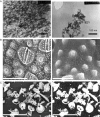Silica in plants: biological, biochemical and chemical studies
- PMID: 17921489
- PMCID: PMC2759229
- DOI: 10.1093/aob/mcm247
Silica in plants: biological, biochemical and chemical studies
Abstract
Background: The incorporation of silica within the plant cell wall has been well documented by botanists and materials scientists; however, the means by which plants are able to transport silicon and control its polymerization, together with the roles of silica in situ, are not fully understood.
Recent progress: Recent studies into the mechanisms by which silicification proceeds have identified the following: an energy-dependent Si transporter; Si as a biologically active element triggering natural defence mechanisms; and the means by which abiotic toxicities are alleviated by silica. A full understanding of silica formation in vivo still requires an elucidation of the role played by the environment in which silica formation occurs. Results from in-vitro studies of the effects of cell-wall components associated with polymerized silica on mineral formation illustrate the interactions occurring between the biomolecules and silica, and the effects their presence has on the mineralized structures so formed.
Scope: This Botanical Briefing describes the uptake, storage and function of Si, and discusses the role biomolecules play when incorporated into model systems of silica polymerization as well as future directions for research in this field.
Figures


References
-
- Bélanger RR, Benhamou N, Menzies JG. Cytological evidence of an active role of silicon in wheat resistance to powdery mildew (Blumeria graminis f. sp tritici) Phytopathology. 2003;93:402–412. - PubMed
-
- Belton D, Paine G, Patwardhan SV, Perry CC. Towards an understanding of (bio)silicification: the role of amino acids and lysine oligomers in silicification. Journal of Materials Chemistry. 2004;14:2231–2241.
-
- Belton D, Patwardhan SV, Perry CC. Putrescine homologues control silica morphogenesis by electrostatic interactions and the hydrophobic effect. Chemical Communications. 2005;27:3475–3477. - PubMed
-
- Belton DJ, Patwardhan SV, Perry CC. Spermine, spermidine and their analogues generate tailored silcas. Journal of Materials Chemistry. 2005;15:4629–4638.
-
- Casey WH, Kinrade SD, Knight CTG, Rains DW, Epstein E. Aqueous silicate complexes in wheat. Triticum aestivum L. Plant, Cell and Environment. 2003;27:49–52.
Publication types
MeSH terms
Substances
LinkOut - more resources
Full Text Sources
Other Literature Sources

